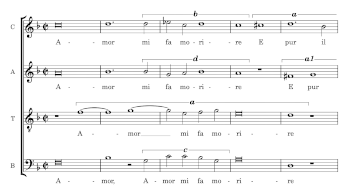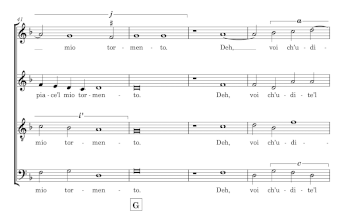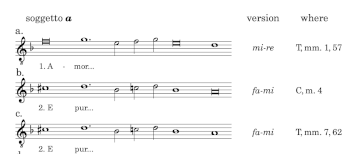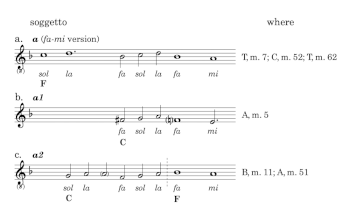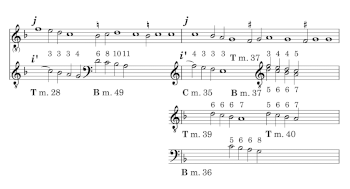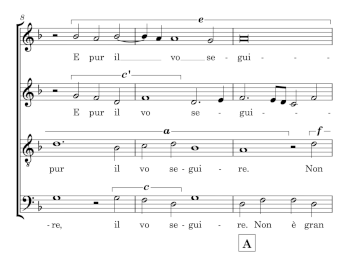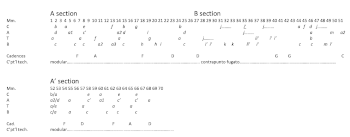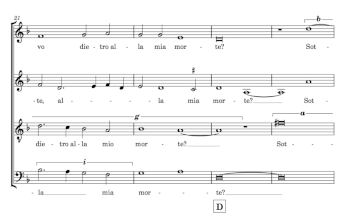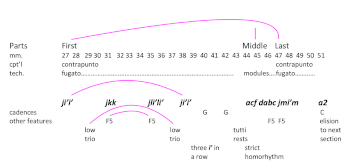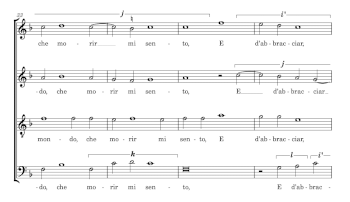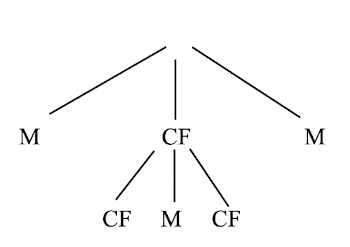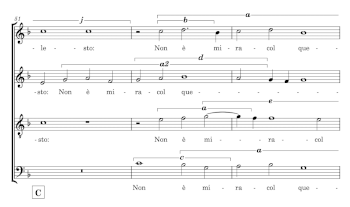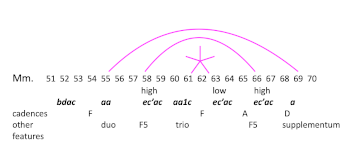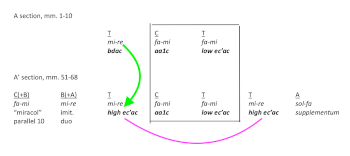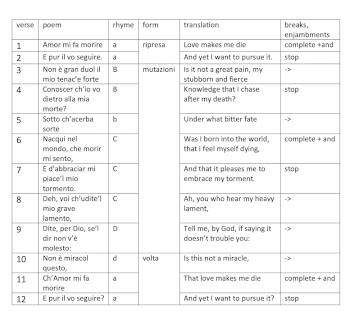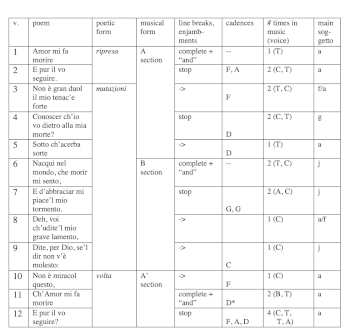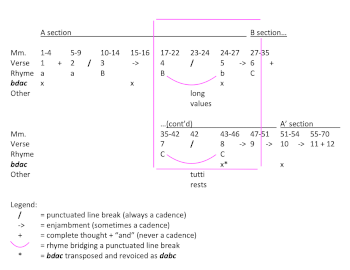Sometimes the Music Wins: Text and Music in a Willaert Madrigal *
Peter Schubert
KEYWORDS: analysis, Agawu, compositional technique, contrapunto fugato, counterpoint, module, Renaissance, texted music, Willaert, Zarlino
ABSTRACT: This study applies Kofi Agawu’s proposed method for analyzing texted music (1992), in which the music and the text are analyzed separately before they are considered together, to an early madrigal by Willaert. Focusing primarily on counterpoint, I offer a detailed study of Willaert’s complex compositional technique. I show that he responded to the poem in many ways, but at the same time he made many purely musical decisions. Finally, I consider what his motivations for these decisions might have been and enumerate musical means he used to respond to the different aspects of his text.
DOI: 10.30535/mto.27.4.9
Copyright © 2021 Society for Music Theory
I. Introduction
[1.1] While Adrian Willaert was enormously respected as a craftsman who influenced later generations of composers, the details of his compositional technique have not been sufficiently examined. We can only imagine what lies behind this famous anecdote (supposedly recounted by Parabosco): “Adriano when he composes puts all his learning and all his industry and thinks and studies very well what he must do before he considers a piece finished and sends his composition out into the world; for no other reason than that is he reputed to be the best in our time” (Zarlino 1588, 326; translated by Feldman 1995, 203, fn 13).(1) Our ignorance of Willaert’s compositional technique might originate in the fact that most of his output consists of texted vocal music, and analysts face a persistent problem in the analysis of any music that has a text. Madrigal scholarship has focused largely on text-music relationships, assuming the music’s role to be an appropriately expressive vehicle for the text. In this view, every musical idea is traceable back to something in the text, and “purely” musical craftsmanship is ignored: the composer’s work ends with finding music that best serves the text.
[1.2] My project in the following study is twofold. First, I will investigate Willaert’s compositional technique, focusing primarily on counterpoint. Harold Powers has summed up composition in the Renaissance as “the elaboration of the soggetto” (1974, 31). This hyper-succinct characterization requires a great deal of unpacking. Renaissance treatises teach many complicated and sophisticated techniques, almost never mentioning the relation of these techniques to any text (except in the vaguest terms). I will show how these techniques appear in an early madrigal by Willaert, temporarily ignoring the text (for the analyst of madrigals, it requires enormous self-discipline to look only at the music—peeking at the text is almost irresistible). I will show Willaert using contrapuntal techniques to build abstract shapes on different scales. Second, reassembling the music and the text, I will see if it is possible to identify which musical ideas originate in the text, and to what extent a madrigal’s music follows its own “purely” musical laws (spoiler alert: I conclude that “sometimes” the latter is the case). When the text, with its own variety of features, is laid next to the analysis of the music, a rich multitude of relationships emerges.
[1.3] The idea of approaching texted music in this way was inspired by Kofi Agawu’s 1992 article on the analysis of German Lieder. He proposed a scenario in which the music is analyzed separately before the text and music are considered together. Because music and text are different semiotic systems, he says, the music “may support, contradict, or be indifferent to the text” (Agawu 1992, 30). I will apply Agawu’s method to an early madrigal by Willaert, “Amor mi fa morire,” (RISM 153415; an annotated score of the complete madrigal is shown in Appendix 1).
[1.4] This madrigal was famous enough in the Renaissance that it is the first piece in Ludovico Balbi’s Musicale essercitio (1589), a collection of canto lines from twenty-seven famous four-part madrigals, to which Balbi cleverly added four new parts (Ignesti 2020, 875–877). “Amor” has been discussed by several musicologists. Alfred Einstein ([1948] 1971, 326–27), Jerome Roche (1972, 35), and Lionel Pike (2018, 67, 72) mention the piece in less than a page, and Erich Hertzmann (1931, 36–40) and Martha Feldman (1995, 204–212) conducted more in-depth analyses. I will compare my findings with theirs at the appropriate time, and also refer to a brief analysis of another early work by Willaert, a French chanson, by Howard Mayer Brown (1980, 218–222). Although Hertzmann and Brown both acknowledged “purely musical” elements in Willaert’s music, they did not elaborate. The idea that the music alone might mean something leads to exciting discoveries about the role of counterpoint in shaping a musical work.
II. Definitions for Musical Analysis
[2.1] The reader wishing to experience the music without the text may listen to the MIDI version in Example 1 or try the performance by Ensemble Arcimboldo on YouTube (bearing in mind that ficta and ornamentation are the performers’ prerogatives).(2) To analyze the music alone, I will begin with what Agawu calls “informal data-gathering,” which consists of collecting “as many significant features of the song as possible” (1992, 11). The musical features I will look at are the melodic soggetti and their presentations, cadences, contrapuntal techniques, register, texture, and quality of dissonance. Some readers may hotly disagree with my choices of “significant features,” definitions, methods, or conclusions, but I have tried to be rigorously systematic.
[2.2] Mine is a “bottom-up” approach, where observations in various domains are assembled into a narrative based on repetition, variation, and contrast. The stories I will tell are about how these features segment the music, how they create abstract shapes, and how these shapes are punctuated by moments of intensification and relaxation.
Example 1. The opening of “Amor mi fa morire” mm. 1–5
(click to enlarge and listen)
[2.3] Identification of soggetti. When analyzing Renaissance music, it is appropriate to begin with melodic material. Zarlino says the soggetto is what the composer needs to get started, and he defines it as, among other things, a melody that carries a complete verbal phrase or an idea.(3) Some of the soggetti in “Amor” are immediately acceptable as soggetti under Zarlino’s definition. In Example 1, the opening of the madrigal, the Tenor melody (a, bracketed) coincides exactly with the first verse of the text, a complete thought, and has rests before and after; even if it were not repeated thirteen times, it would probably be awarded the status of soggetto.
[2.4] However, in the context of Willaert’s music, and because I am temporarily disregarding the text, I abandon Zarlino’s requirement that a meaningful melody must carry a complete verbal phrase or thought. I call any melodic thing that repeats in a meaningful way a soggetto. My definition of meaningful is twofold. First, it applies to any melodic segment (usually four or more notes long) that repeats.(4) This criterion often entails identifying segments that appear within longer lines. For instance, in Example 1, soggetto b is sliced out of the longer Cantus line. Why not include the Cantus’s first two notes? Because no repetition of soggetto b (in e.g., m. 15, m. 24), contains those first two notes. My defining principle is to label the longest version that is repeated, and to include those two notes would be to abandon the principle of structural repetition for the sake of the apparent organic “wholeness” of the melodic line. Additionally, someone might point out that the Cantus is pre-imitating the Tenor, which is true, but since those two notes never come back attached to b, they have a different kind of meaning. They may be part of a beautiful whole, and they may relate to the Tenor, but they are not part of a structure based on repetition, which is what I am after.
Example 2. “Amor,” mm. 41–48 (soggetti a and c in m. 44; soggetti a, b, c, and d in m. 46)
(click to enlarge and see the rest)
[2.5] The second form of meaningful repetition is contrapuntal context, which can be used to identify much shorter bits of the same soggetti. These fragments might be thought of as passi, or short motives, but calling them by the same name as their longer versions gives them equal structural importance and avoids having to declare a threshold for a minimum length. For instance, in m. 44, notes 3–5 of a appear in the Cantus (Example 2). We can be sure they are from soggetto a because they are paired with notes 3–5 of c in the bass and make the same interval succession as they did in. m. 3 (3–5–8, now compounded). Likewise, soggetti a and c make brief appearances in m. 46, now reduced to only two notes (and transposed). Here they too are sounded in the same relationship as in m. 3 with a two-note fragment of soggetto b and four notes of soggetto d, albeit transposed and rotated in space. These fragments are not preceded and followed by their melodic partners, and they might seem too short, even generic, to be considered more than conventional voice leading motions, but it would be a mistake to disregard that they form the same module (or “chord progression”), with the same voice leading motions, as in mm. 3, 15, 25, and 52. Modules, which depend as much on vertical relationships as horizontal ones, are discussed further in section 2.12.
[2.6] While this method of analysis seems artificial if we want the surface and the structure to align and be perceptible, Willaert’s melodic style demands this treatment. He regularly buries meaningful melodic fragments seamlessly within longer lines.(5) Willaert’s melodies have received a fair amount of attention (for a brief and entertaining survey, see McKinney 2009, 33–34). Howard Mayer Brown, analyzing an early French chanson by Willaert, wrote: “His musical phrases are carefully shaped—they usually rise gradually to a high point before sinking back down to the cadence—but apparently according to purely musical laws” (1980, 220). Brown does not say what the purely musical laws might be. I believe that their shaping is only partly a matter of expressing a text (section 5 below); more important is what contrapuntal opportunities they offer when they serve a purely musical function in building larger shapes (section 5.3.4).
[2.7] Placement and transposition of soggetti. Hertzmann says that the norm in early madrigals is for significant melodic material to appear in the Cantus: “The top voice in this [type of] madrigal is melodically the most important, the others take a secondary role. Only the Tenor sometimes takes the lead—probably a reminiscence of Netherlandish cantus firmus technique” (1931, 36).(6) However, for him, “Amor” is an exception: “If the treble played a predominant role in Willaert's other madrigals of this period, then, as the table shows, this role must be assigned to the Tenor.”(7) (1931, 39–40; see Appendix 2, where he diagrams melodies in the Cantus and Tenor). Martha Feldman focuses only on melodies in the Cantus, ignoring the Tenor.(8) Neither author comments on thematic occurrences in the Bassus and Altus.
Example 3. The thirteen occurrences of soggetto a (the first note of the Tenor in mm. 57 and 65 is a semibreve)
(click to enlarge and see the rest)
[2.8] Soggetto a occurs mostly in the Tenor and Cantus parts (seven times in the Tenor and three in the Cantus), which is common in French chansons and early madrigals.(9) Example 3 shows the different forms it takes. Ten of these forms start either on C (or
[2.9] Soggetto a also appears in other voices. The Bassus has the mi-re version down an octave (Example 3h). The Altus has two: a mi-re version (Example 3g, transposed a fifth down to the F hexachord and lacking its first and last notes); and one in the supplementum, the extension of the final after the last cadence (m. 68).(11) This one has different semitone positions, and is called the sol-fa version. When the soprano fa-mi version in m. 52 (Example 3f) is doubled in parallel tenths by the bass, we could call the bass a re-ut version, but I have chosen to regard it as a mere doubling. Finally, the Altus has the exceptional two-note fragment of the mi-re version transposed up a fifth (m. 46, shown in Example 2) that was discussed above. These unusual placements have both formal and expressive meanings, as we will see.
Example 4. Variations of soggetto a
(click to enlarge and see the rest)
[2.10] Variations of soggetti. Example 4 shows variations of the fa-mi version of soggetto a, called a1, a2 and d. The last two result from inganno, a favorite device of Willaert’s, in which the hexachord names are the same in both the original and the variation, but the intervals and even the contour can change depending on which hexachord the syllables are drawn from (Jackson 1968; Harper 1978; Trantham 1993; Schubert 2003; Van Damme 2009). A dotted line indicates where the melody switches between the hexachord on C and the one on F (bold in the example). This permits us to see relationships between apparently different melodies. Soggetto d gets a different label to acknowledge its appearances along with a in the vertical four-voice combination bdac (see Example 1); thus in m. 15, it appears both as part of that combination and as a part of a2 melodically. Example 4e shows that motive a2 can also be found in mm. 14–17 by borrowing two notes from the Tenor part. Because the lines move in parallel fourths, and the C and F hexachords are a fourth apart, the solmization names in Example 4e apply to both voices. In only one case do I allow a soggetto to lack a note other than at the beginning or end (b in m. 25 is missing a C). As will be shown in section 3.7, soggetti can be dovetailed in a single voice when they share a melodic interval.
[2.11] Two other soggetti come in different versions. Soggetto c’ always appears in combination with c, but it starts two minims earlier, and is only the same for three notes (see Example 1). This is one of a few examples of close imitation in the madrigal. Another soggetto that comes in two different versions is i, four stepwise descending minims; i’ differs from i in that it starts on a weak minim, and consequently makes different contrapuntal demands and opportunities. Soggetto i’ appears twice preceded by two-note soggetto l (mm. 36–38; see Example 11); one could lump these two together, but because i’ appears so many times alone, it seemed preferable to give l a separate label, and not to recognize all the other i’s as reduced versions.
[2.12] Combinations of soggetti (modules). We have observed that soggetti are sometimes combined in the same relationships (section 2.5), making modules (Owens 1984, 284; Schubert 2007). Soggetti a and c occur together in the same relationship ten times in the Tenor and Bassus: five times with b and d in the Cantus and Altus, four times with c’ and e, and once with free material (m. 44). Walter Gerstenberg cautiously calls such four-voice combinations “characteristic sequences of sound” (1966, vi), and I have referred to a two-chord progression in a Willaert ricercar as a “harmonic signpost” (2003, 104–105). The only other modules in the piece are two-voice combinations f against a2, and g against h and i, both appearing only twice. Tracking the occurrences of these modules and their transpositions is one way to find structure.
[2.13] Cadences. The definition of cadence is a vexed issue in early music analysis (Fromson 1991). My definition of cadence is quite restrictive: it is a two-voice combination making a sixth to an octave (or a third to a unison), preceded by a dissonant suspension and arriving at a goal that is completely consonant. Some things that might plausibly look to the reader like cadences will not be acknowledged here. I find no cadence in m. 5, because of the lack of suspension; nor in mm. 13, 38, and 66, because the goal sonority is vitiated by an overlapping dissonance in the Cantus; nor in m. 35, where the Altus evades the cadence by not moving to the expected unison; nor in m. 60, where the goal D in the top voice is delayed by a minim rest on the downbeat.
[2.14] On the other hand, some things that might be taken as evaded cadences I consider fully structural, like the Cantus-Tenor cadence to D in m. 27, even though the Bassus has
[2.15] Contrapuntal Techniques. The use of a contrapuntal technique can by itself define contrasting sections. This criterion has not been much used in early music analysis. Christopher Reynolds’s article on a Josquin chanson is an exception, where he shows canons at different intervals marking out a palindrome (1987). In “Amor,” there are two different techniques in use: modular construction (described above in in section 2.12) and contrapunto fugato, which consists of the repeated placement of a short soggetto against a longer one (Schubert 2020). Contrapunto fugato stands in contrast to modular construction by its irregularity: new, non-repeating combinations are being constantly introduced. Brown noticed an instance of this type of irregularity in his French chanson, referring to it as “a relatively intricate and ingenious network of motives and free material. In the beginning phrase, for example, the contratenor states a countersubject which is displaced by one bar when it returns in the bass
Example 5. Contrapunto fugato: placements of i’ against two transpositions of j (cf. Example 11)
(click to enlarge)
[2.16] In “Amor,” this technique is applied to soggetto j, which is presented as a “figurated” cantus firmus (i.e., a melody in mixed note values), sounded five times at two different transposition levels (starting on F and C). It appears like a shark, with shorter soggetti i’, k, l and m attached like remoras.(12) The soggetto with which it is most often combined is i’ (see Example 11). Example 5 shows the various transpositions and temporal positions of the eight placements of soggetto i’ against j. Soggetto i’ variously starts against the first, second, fourth, fifth, and seventh notes of j. Two i’s start on the second note (mm. 28 and 39) but make different interval combinations because they are different interval distances from j. Three i’s start on the seventh note, of which two make different interval combinations while one is the same. All of these placements are different except for the one duplicate that can be called modular (mm. 37 and 40, making vertical intervals 5-6-6-7). This constitutes an exception to the almost exclusive use of variation, and it serves a formal function, as we will see.
[2.17] Imitation, supposedly the bread and butter of Renaissance music, is not much used in this piece. As Hertzmann says “Every now and then one can find a workmanlike imitation, but generally in such cases we are dealing more with a free contrapuntal or motivic procedure.”(13) Brief imitations are found between c and c’ (mm. 8–9, 58–59, and 63–64 and 66–67) and between transpositions of a in the duo near the end (mm. 55–56). Imitation can also be identified in some of the statements of soggetto i’, notably when i’ is preceded by l (Example 11, mm. 36–38); this is more complex than mere imitation, however, conditioned as it is by the obligation to conform to soggetto j.
[2.18] Register and Texture. The highest note in the piece is the Cantus F5, and the lowest is the Bassus C3. These are reached simultaneously in m. 66, which will be one reason to call this a climactic moment. The first high F5 occurs in the middle of the A section. The three in the B section and the two in the A’ section serve various functions, as we will see. Observers have commented on the general uniformity of texture in Willaert’s music,(14) but here we find some small but noticeable (at least three semibreves long) reductions in the number of voices: four trios and one duo. As we will see, these changes of texture coincide with markers in other dimensions, and thus are formally significant.
Example 6. Two versions of the ec’ac module
(click to enlarge and see the rest)
[2.19] Dissonance. Dissonance treatment is conventional, but in one case the quality of dissonance has a real impact. The ec’ac module occurs at two pitch levels (Example 6). The first one I call the fa-mi version based on the first two notes of soggetto e in the F hexachord (
III. Analysis of the Music
[3.1] The above observations can be assembled into different narratives. They enable us to break the piece down into sections and subsections, and to identify “special” places in the piece, striking moments of contrast that result from the coincidence of exceptional details in different domains.
Example 7. A timeline of the madrigal, showing soggetti, cadences, and contrapuntal techniques
(click to enlarge)
[3.2] Largest Sections. Example 7 shows all the soggetti placed on a timeline in their respective voices in the top four rows, with cadences and contrapuntal techniques mapped onto the same timeline. A picture comes into focus based on the coincidence of features in three domains. Soggetti: In the first 27 measures, we find only soggetti a–i; between mm. 27 and 51, soggetti i’–m are dominant (a, a2, b, c, and d make one appearance each); and from 51 to the end, only soggetti a–e are heard. Cadences: Those boundaries (27 and 51) also correspond to the exclusive presence of cadences to F, A and D in the first and last sections, and G and C in the middle section.(15) Contrapuntal techniques: These correspond as well, the outer sections using only modular techniques and the middle consisting of contrapunto fugato with one small insertion of modular construction. The coincidence of change in these three domains is an argument for a narrative that says the piece has a contrasting middle, and is what causes us to put the large labels “A section,” etc. above the diagram in Example 7. These sections do not correspond with Hertzmann’s (reproduced in Appendix 2). He used long rhythmic values (mm. 23–24), tutti rests (m. 43), and the textual return (m. 54) to arrive at his four-part sectionalisation.(16) (Unfortunately, his melodic labels are opaque; he provides no musical examples or detailed measure numbers, so it is difficult to verify the form.)(17) Peering more closely at Example 7, we will now find patterns inside each of the three major parts.
Example 8. Detail of the A section
(click to enlarge)
Example 9. Mm. 21–28. New beginning or completion of arch in mm. 23–24? Tight elision into B section in mm. 26–27
(click to enlarge and see the rest)
[3.3] Sub-sections. Hertzmann, referring to early madrigals in general, wrote, “As far as the formal aspect is concerned, these compositions are characterized by sure architecture. The large form is very clearly expressed, while the subsections are regularly blurred.”(18) Yet these smaller segments also have clear, carefully crafted shapes. Within the A section the bdac module occurs three times, more or less evenly spaced. The first one is set off from the others by a short trio (mm. 6–7) between the two Tenor statements of soggetto a. Since the two outer ones are full length, and the middle one is shorter, they suggest a small palindrome, or arch form. The placement of soggetti f and g about the middle is also symmetrical: f is sounded first in the Tenor, then in the Cantus, while g is the reverse. The first high F5 occurs in the middle of this arch, marking a climax right before the short bdac module. Some features appear to conflict with this symmetrical interpretation. These features, shown with stars in Example 8, are also symmetrically disposed about the center, but are of different types: The first has three elements: the aa1c trio, cadence to F, and ec’ac module in mm. 6–11; the other is the cadence and long values in mm. 23–24. This latter is a puzzling moment, because the long values at the cadence to D make us think a major section is over, but the phrase that follows continues the same material. Is the restatement of soggetto a in the Tenor (Example 9, m. 24) to be interpreted as a new beginning or the completion of the arch?(19) This moment becomes even more complex when the text is considered alongside it.
Example 10. Detail of large B section
(click to enlarge)
[3.4] The large B section can also be parsed into a three-part form, as shown in Example 10. The first part is long, consisting of four statements soggetto j accompanied variously by i, i’, k, and l. The contrasting middle is built on the modular technique and soggetti that were used in the large A section. The last part returns to a statement of j with soggetti i’ and m.
[3.5] The first part of the B section can itself be parsed as an arch whose outer pillars are the exclusive use of i’ to accompany j (note that the i’s in the left pillar make different counterpoint from those in the right pillar, as shown in Example 5); inside that are the low trios; and in the center are the high F5s. Willaert carefully balances trios with high points to create contrast in these measures that are otherwise so thematically consistent. This first part comes to an end when soggetto i’ is sounded three times in a row at the same pitch level, twice by the Tenor and once by the Bassus (shown in Example 11). This moment is special because, as we observed (section 2.16), one of these occurrences is a deviation from the consistently varied placement of i’ against j. The ostinato-like insistence, coupled with acceleration of cadential frequency (cadences to G in mm. 40 and 42) builds momentum into the dramatic tutti rests. The middle part is climactic due to the two high F5s, the fragmentary bdac module, now transposed up, and the strict homorhythm. The last part returns to the repetitions of the long soggetto j that provide uniform, continuous background for the dramatic interruption at m. 44. The relaxation continues as soggetto a2 in the Altus elides after the cadence to C, seamlessly returning to the A’ section.
Example 11. Mm. 33–44. Imitation of l + i’ in mm. 36–38; acceleration of i’ in mm. 37–41; and more frequent cadences to G in mm. 40 & 42 (the ji’ pair in m. 38 makes the same contrapuntal combination as that in m. 41) (click to enlarge and see the rest) | Example 12. Nested structures (M=modular, CF=contrapunto fugato) (click to enlarge) |
[3.6] The bit of modular construction inserted between the two outer sections is like a mirror image in microcosm of the large-scale insertion of a contrapunto fugato B section in between two modular A sections. The modular interruption marks the middle of the middle (Example 12).
Example 13. Mm. 51–57: a contrapuntal tour de force and the only duo
(click to enlarge and see the rest)
[3.7] While the A’ section is characterized by the same soggetti, cadential goals, and contrapuntal technique as the A section, the first part of this return (mm. 51–54) is unique in the piece. In each voice, two soggetti are dovetailed in a contrapuntal tour de force, as shown in Example 13. I have mentioned that Willaert’s melodic style involves sounding meaningful fragments within longer lines (sections 2.6 and 2.10). Here he plays with the double meaning of melodic intervals. In the Cantus, the third and fourth notes of the original b double as the first two notes of a; in the Altus, as we have observed, d is a part of a2; in the Tenor, the fifth note of a becomes the first note of e; and in the Bassus the third and fourth notes of c are reinterpreted as the second and third notes of a transposed down a tenth as the bass doubles the soprano in parallel tenths (a unique presentation of this soggetto). This phrase contains another bdac module, which is beginning to acquire the status of a ritornello.
[3.8] This is followed by another unique feature, the low-voice duo (Altus and Bassus, mm. 55–56) that contains a bit of imitation at the semibreve, with a five-note fragment of a in the Altus. This consists of the second through sixth notes of mi-re version transposed down a fifth (it would normally begin on
Example 14. Detail of A’ section
(click to enlarge)
[3.9] This final section of the piece can also be interpreted as a little arch (Example 14). The middle is characterized by the aa1c trio and ec’ac module (mm. 60–62) exactly as they appeared in mm. 5–7 (shown by a star, as in Example 8). On either side of this quotation, we find two ec’ac modules, the higher and more dissonant version, both immediately preceded by F5 in the Cantus. On either side of these we find the statements of soggetto a in the Altus.
Example 15. Statements of soggetto a in the beginning of the A section and the complete A’ section
(click to enlarge)
[3.10] If we compare the A section to the A’ section, we can see how Willaert carefully planned his dramatic finale (see Example 15). In the first ten measures, soggetto a was presented three times: first the mi-re version in the Tenor, then the fa-mi version in the Cantus, and finally an octave lower in the Tenor. Only two of these recur in the A’ section (mm. 51–68). There are three functions that make the end special: climactic, recapitulatory, and summative. It is climactic due to the higher register, increased dissonance, and repetition of ec’ac at the end. It is recapitulatory in that soggetto a doesn’t come back in the original voice at the original pitch level (the mi-re version) until m. 57. (I have said that the A’ section begins in m. 51, but that a is in the “wrong” voice.) However, a is sounded as part of a different module: it reappears as part of the ec’ac module instead of the bdac module as at the beginning. The mi-re version and soggetti c, c’ and e had been kept separate until now, so their combination now has a summative function.
[3.11] Summary. The melodic content, cadential goals, and contrapuntal techniques line up to affirm a large ABA’ form. Each of these sections in turn contains a smaller three-part shape that contains a major climax. The many arch forms that occur on smaller scales are made by carefully placed repetitions of elements in the same domain; these domains include placements of soggetti and modules, texture, contrapuntal technique, and high points. Willaert introduces more variety in different domains as the piece goes along, reminding us of Lester’s “heightening” narrative (2001). This developmental story is supported by the elements that differentiate the A’ section from the A section. Another stretch of intensification comes in the large B section with compressed repetition of i’ and cadences to G leading into the climax: the fourth statement of the bdac “ritornello,” with three voices transposed up a fifth. These structures and moments of tension are not easily heard at first blush, but they can be learned.
IV. The Poem
Example 16. Lower case letters in the third column (under “rhyme”) indicate seven-syllable verses; uppercase letters are eleven-syllable verses. The last two verses are the ripresa inside the volta.
(click to enlarge)
[4.1] Form. The poem is a ballata-madrigal (Harrán 1969, 28), whose formal elements are the first couplet (the ripresa), the mutazioni, and the final section, the volta, which ends with the opening couplet. Verses 3–9 are structurally the mutazioni, which usually consist of smaller units formally similar to each other, but in this case it is not clear where the smaller units begin and end; Harrán classifies this poem as having irregular mutazioni (1969, 32). All of the mutazioni verses have eleven syllables but one, while the ripresa and volta have seven (see Example 16). Verse 9 can be considered a concatenazione, linking the end of the mutazioni with the volta by means of the rhyme (Harrán 1969, 30).
[4.2] Enjambments, punctuation, and rhyme. Verse 5 begins after a completed thought (the question in v. 4), and because it is an incomplete thought (no verb is present), it is strongly enjambed with the next verse in expectation of the verb, which arrives at the beginning of v. 6. In that sense it looks forward; but its rhyme ties it to the previous two verses, 3 and 4. Likewise v. 8 begins after a completed thought and is strongly enjambed with v. 9 in expectation of the verb, which comes at the beginning of v.9. It too looks back to vv. 6 and 7 with which it rhymes. A tension exists between the punctuated line breaks and the continuity of like rhymes (perhaps the poet has “problematized” the formal boundaries of the poem).
[4.3] The enjambments of vv. 8–11 also deserve a closer look. Verse 8 is an address, and so demands a continuation: the listener asks, “ok, I hear your heavy lament, what do you want from me?” Then v. 9 requires a direct object—the listener asks, “tell you what?” Verse 10, the onset of the volta, also demands a continuation: “isn’t what a miracle?” All of these push powerfully towards the ripresa. The reason we must attend to these connections between lines is that they are the locus of tension between the rhythm of the lines and their meaning. How will Willaert address these moments—will he favor line breaks or continuity of thought? Can he do both? The poem does not contain any caesuras (when a thought is completed in the middle of a line), so we do not expect any musical articulation in mid-line.
[4.4] Semantic dimension. The meaning of the text is the apparent paradox that although love makes the poet die, he wants to follow it. The paradox is an expression of the well-known “death = orgasm” conceit. The opening couplet sets out the problem, and the mutaztioni are reflections on that paradox. Verses 8 and 9 address the listener and function as a transition to set up the volta as a punch line. A unique feature of the poem is the exclamation “Deh” that begins line 8 and the address to the listener.
V. The Text and the Music
[5.1] In the following section, I will look for instances where the music and text mutually correspond (or support) each other, and later, where they do not. Once structural designs and moments of tension in both the music and in the text are identified, complex relationships can be revealed by laying the two analyses side by side.
[5.2.1] Correspondence. The text has structural features (vowels, syllable count, word accents, large-scale structure, rhyme, grammatical structure, and line breaks) that can correspond to musical ones. In addition, the text has a semantic dimension that can be “represented” in the music according to certain conventions. In the following sections, Willaert’s musical decisions can be attributed to the text.
[5.2.2] Vowels. As Lionel Pike (2018, 67) has pointed out, the vowels in the first line of the poem, “Amor mi fa morire” translate to musical syllables fa sol mi fa sol mi re and generate what I have called the mi-re version of soggetto a in the Tenor. This technique is called soggetto cavato (Zarlino 1558, 267; Haar 1975).(20) This aspect of the text is neither semantic nor structural, it comes from a musical pun suggested by two words in the first line. As Pike notes, this pun would not have been lost on the Renaissance singer or listener: “It would scarcely have been possible for a Renaissance musician to sing
[5.2.3] Of these syllables, the musical potential of the mi-fa pair gets carried to an extreme. First, we have the striking cross relation in the opening measures, where the cantus sings “mi fa” on D-
[5.2.4] Verse structure and word accents. The numbers of notes in the principal melodic soggetti correspond to the numbers of syllables in the verses they set. Soggetto a consists of seven notes and sets seven-syllable verses 1, 2, 5, 10, 11, and 12. Two exceptional uses of a within eleven-syllable lines are in line 3 (see Appendix 1, mm. 14–16) and the tiny fragment of a in v. 8 (see Example 2). Likewise, soggetti g and j have eleven notes: g sets v. 4, and j sets vv. 6, 7, and 9. Word accents also correspond, with longer and/or metrically stronger notes setting accented syllables. (This results in a certain rhythmic consistency in the setting of seven- and eleven-syllable lines that is beyond the scope of this study.)
[5.2.5] The puzzling return of soggetto a in m. 24 (see section 3.3 and Example 9) might be explained by the simple fact that v. 5 is the only seven-syllable verse in the mutazioni. Hertzmann also found it puzzling but had a different interpretation. Having used the cadence in m. 23, followed by long values, to mark the end of the first section, he explained the subsequent statement of a in the Tenor in mm. 24–26 by stepping outside of text-music relations: “The dominant position of the Tenor becomes especially clear at the beginning of the second section. Here it starts again with the introductory motif, which is neither justified by text form nor content—hence a purely musical-tectonic artifice—while the treble counterpoints with new material (the discant cadence in bars 26–27 is particularly noteworthy)” (1931, 40).(21) Herzmann’s “purely musical-tectonic” reason might be that it completes the arch that makes up the A section; in section 5.2.8, yet another interpretation is offered.
Example 17. The poem and the music
(click to enlarge)
[5.2.6] Line breaks. Analysts of madrigals often distinguish whether the composer seems to be making the music correspond to the versification or to the thought. That is, are line breaks musically articulated, or are enjambments respected by continuous music? The musical feature most often adduced to reflect grammatical breaks is the cadence. Comparing columns 5 and 6 in Example 17, we see that a punctuated line break in the text (“stop”) is always reflected by a cadence in the music. Another consistent correspondence is the lack of cadence between two verses that express a complete thought but are followed by “and,” where Willaert perhaps wants to emphasize that the thought is going to continue. This happens between vv. 1–2, 6–7, and 11–12 (v. 11 is, exceptionally, sounded twice).
[5.2.7] Large-scale formal structure. The return of the music that corresponds to the return of the opening couplet has been widely recognized. Hertzmann says: “The predominance of the tenor is not compromised by the anticipation of the recapitulation in the Cantus.”(22) He is referring to soggetto a in the Cantus in v. 10; interpreting that as an anticipation means he wants the true musical recapitulation to coincide with the final couplet. Einstein vaguely but rhapsodically says: “The formal rounding out of the piece is demanded by the text: but how delicately Willaert veils or covers over the bare repetition of the opening!” ([1948] 1971, 326). He may have been thinking of the understated musical return of soggetto a in the low-voice duo (Example 13). Feldman says: “Willaert mirrors—even outstrips—the text’s elision into the ripresa, postponing it musically beyond the poetic return—that is, until the end of v. 11 (cf. mm. 3–5 with mm. 59–60),” (1995, 204.(23) Perhaps she sees the recap coming so much later because she does not reckon with soggetti in other voices than the Cantus. Hertzmann and Feldman do not agree about where the musical recap is, and neither places it exactly at the start of the volta, as I do in Example 17.
Example 18. Rhyme, punctuation, and music
(click to enlarge)
[5.2.8] Rhyme and Punctuation. Hertzmann and I were puzzled (see section 5.2.5) by the statement of a in the Tenor in mm. 24–26 after the long cadential goal in mm. 23–24, initially adducing both textual and musical reasons for it. Another justification for this return is that it links back to the other verses that v. 5 rhymes with. As noted in section 4.2, the rhyme scheme twice crosses over punctuated line beaks: between vv. 4 and 5 and between vv. 8 and 9. These two moments of poetic tension are treated very similarly by Willaert (they appear boxed in Example 18, one above the other). Verses 4 and 7 are ends of thoughts that are musically punctuated by cadences and either long values or tutti rests, and vv. 5 and 8 begin new trains of thought but retain the rhyme of the two verses that precede them and sound the bdac module. The new beginnings are both immediately elided with vv. 6 and 9, respectively. Thus, Willaert has created in mm. 17–35 a musical response to the tension in the poem, and then reused it in mm. 35–51. It’s as if he wants to have his cake and eat it too, respecting versification with a cadence while respecting the enjambment with the elision. The second time is more dramatic because of rests, register and homorhythmic texture, and so can play into a narrative of intensification.
[5.2.9] Semantic dimension. Word painting has not been found much in Willaert’s early madrigals. The most convincing example of correspondence is the tutti rests preceding the exclamation “Deh” at the beginning of verse 8 (Example 2). They constitute a musical interruption into the continuous flow of soggetto j, and are preceded by an exceptional repetition of soggetto i’ and acceleration of cadences (see Example 11). This moment is unique both in the text (the only exclamation) and in the music (the only tutti silence). Other examples of word painting include the low register in all voices at “morte” (m. 23) and the cross-related
[5.2.10] Charles Sanders Peirce’s three categories of resemblances in different domains (icon, index, and symbol) provide a useful model for making more precise evaluations of word painting (Atkin 2013, section 1). An icon is something that shares a similarity with the object. The shared quality between a chord after a silence and the exclamation “Deh” after a period is explosive suddenness. An index is a kind of metonymy where a result is taken as the representation of the cause. Raymond Monelle’s colorful example is a hole in the window as a sign of a bullet having passed through (2000, 15). The low voices and the word “morte” might be an example of an index, the result of causation (“My voice falls when I think about death” or “we lower the dead into the grave”). However, it might be a symbol. Symbols “depend on learned cultural codes” (Monelle 2000, 14). If the low register is a symbol, it is because we have been taught to associate low register with sad things, and death is one of those. The use of cross relations to represent pain is likewise a symbol.
[5.2.11] The placement of an important word in a structurally important musical location is an altogether different kind of correspondence. The fact that “Deh” appears in the “middle’s middle” (see Example 12) is not conventional word painting. The duo that brings back the ripresa is another correspondence of music (in this case, contrast of musical texture) and text (the ripresa). The use of homorhythm at “my grave lament” is likewise not any kind of representation, but merely provides a kind of emphasis.(25)
[5.3.1] Indifference. Agawu’s other categories of text-music relations, indifference and contradiction, are difficult to separate; in both, the music seems to go its own “purely musical” way. Furthermore, it is hard to prove that the music doesn’t have some deeply hidden relationship to the text. Just because one observer can’t see a correspondence with the text, another might come along and show us one. Here’s an example: Because soggetto a sets five different verses, and soggetto j sets three different verses (Example 17), all with different meanings, I think both melodies are wholly indifferent to the semantic aspect of the text.
[5.3.2] Pike, however, believes that the opening soggetto a, repeating later with different words, has a purpose: “the tenor part, fa-sol-mi-fa-sol-mi-re, gives a short musical tag which recurs from time to time throughout the piece, usually to different words which do not themselves share the hexachord sounds suggested by those notes. By using this tag to recall the hexachord sounds of the opening line of the poem, Willaert reminds the singers, at intervals, of the text’s opening – and fundamental – idea” (2018, 67). Later he says the melody notes, through solmization “recall, like a leitmotif, the main burden of the poem” (2018, 72). Thus we must conclude that some melodies are text-related and others (like j and the fa-mi version of a) may be purely musical. Certainly, we can see that the shorter soggetti are entirely indifferent: they come and go when they are contrapuntally needed or afforded, and the syllables sung on those notes appear to be opportunistically placed (compare, for instance, the syllables attached to soggetto i in mm. 19 and 21 in Appendix 1).
[5.3.3] Other musical features serve both formal and text-related functions: I have referred to the bdac modules as “ritornelli” (sections 3.7 and 3.10). When they mark out the beginning, middle and end of the large arch that is the A section, they do indeed serve a purely musical function (and contradict the poetic boundary between ripresa and mutatzioni (as shown in columns 3 and 4 of Example 17). However, when they occur as part of a constellation that bridges the rhyme/line break gap (see Example 18), they have a text-related function.
[5.3.4] The small-scale constructions within the three sections seem to me to be altogether indifferent to the poem. These depend on multiple repetitions of soggetti a and j. Here the music has an agenda, to build long sections that can be interrupted dramatically. Willaert may have initially decided, looking at the text, where to place these interruptions, but how he structures the long sections that surround them is a matter of finding a contrapuntal technique, some appropriate tunes, and how to lay the tunes out so as to stretch out some time. These tiny shapes (diagrammed in Examples 8, 10 and 14) are in no way related to their text: the text is hung on the music, which follows its own laws. Counterpoint is more than following rules of voice leading, it provides ways to build long, well-formed sections.
[5.3.5] Nor does texture seem to reflect any aspect of the text. The two low trios in the B section (Example 10) seem to be attached to registral extremes in the Cantus in a symmetrical disposition, and the two trios on aa1c are structural components of the A and A’ sections. Only the duo that brings back the ripresa might have a textual motivation (section 5.2.11).
[5.4.1] Contradiction. It is difficult to make a strong argument for a contradictory relationship between music and text, because to contradict each other, they must be directly comparable in some way. The only comparable feature they share is an ending, and if the musical and textual endings do not coincide, that could be taken as a structural contradiction. This is the kind of contradiction Agawu finds in his Schumann song, a cadence at a line where the text is open-ended (1992, 19).
[5.4.2] The textual completion of v. 12 occurs in the Cantus in m. 62; after that we hear it stated three more times through m. 70. This means that the text ends long before the music. We know that repeating music at the end of a madrigal is common, but is it because of the text, or in spite of it? A famous example is the end of Arcadelt’s “il bianco e dolce cigno,” where the poet says, “I would be happy to die a thousand times a day.”(26) One can commonsensically assert that Arcadelt’s musical repetitions of that verse are motivated by the meaning of the text, where repeated orgasms = repeated music. (Someone might even claim the same for “Amor,” where the poet “dies” from love, and yet wants to follow it—maybe he wants to follow it many times, even though he doesn’t say so.)
[5.4.3] Someone might also argue that the repetitions of the climactic ec’ac modules setting v. 12 depict a dramatic reading of the poem by a skilled orator, representing the tormented lover harshly (by quality of dissonance) raising his voice (by register), and insisting (by repetition) on how ironic it is that he wishes to follow love even though it makes him suffer. This is a nice idea, but it cannot be proven by systematic analysis. It adds to the richness of our experience of the madrigal, and might have even been intended by the composer. But the musical convention of ending with literal or varied repetition is too widespread to assert that it always represents a textual idea.
[5.4.4] Pietro Pontio addresses this question. “Also, it is appropriate for the composer and the contrapuntist to avoid (if possible) repeating the inventions with the same consonances and associated [rhythmic] movements; because they give no variety at all, unless it is the repetition of an ending, as Cipriano [de Rore] does in the second part of his canzone Alla dolce ombra; if the invention is repeated with different consonances, such variety will be very praiseworthy.”(27) In the case of the Rore, two entire verses are repeated that do not obviously cry out for repetition: “I did not turn for refuge to shadowed hills / but to the tree that's noblest in heaven” (trans. Kline 2002). Pontio does not mention the meaning of the text, and I take him to mean that this is a purely musical exception to Zarlino’s rules about repetition (1558, 227).
[5.4.5] This kind of repetition, then, is a musical convention that can override the text, marking an ending. But what about thematic melodies regularly repeated in Cantus and Tenor in our repertoire (other than the mi-re version of soggetto a that Pike found a rationale for)? I propose these repetitions too, show the music following its own laws and at least being indifferent, if not downright contradictory, to the text. We don’t experience v. 2 followed by v. 3, as a reader would, we hear v. 2 once in the Cantus and once again in the Tenor, not to mention in five variously staggered entries in other voices. The music inserts itself into our experience of the poem.
[5.4.6] Given this musical convention, it might be interesting to consider why Willaert chooses not to repeat certain verses. Those that do not repeat are 1, 5, 8, 9, and 10 (column 7 in Example 17 shows how many times and in which voices verses appear with primary soggetti). Verses 1, 5, 8, and 10 all contain the bdac ritornello and occur at special moments in the piece, as discussed in section 5.3.3. Only v. 9 is different, and it may be that Willaert does not repeat it because it is the concatenazione, linking to volta, and is the second of three enjambed lines that press forward towards the ripresa (noted in section 4.3).
VI. Conclusion
[6.2] Analyzing the music alone permits us to appreciate Willaert’s musical craftsmanship, which begins with tiny melodic bits combined successively and simultaneously. The analysis demands rigor, but offers flexibility in interpretation. Once we have found “the significant features of the song,” and we have worked through issues of continuity and interruption, intensification and relaxation, then we can contemplate a multitude of possible relationships between the text and the music. The influence of the text, when it is felt, takes many forms: some pervade the entirety of the song, and some jump out at special moments. Some musical events serve both to reflect the text and to make purely musical designs.
[6.3] Agawu concludes his article with a provocative quotation from Daniel Leech-Wilkinson: “Argument over the relative importance of music and text in song is as everlasting as it is pointless
[6.4] But my title is intended to qualify Leech-Wilkinson’s remark. While the music of a song may sometimes “win,” many features of “Amor” can clearly be seen as directly inspired by the text: the prosody, the solmization theme, the bits of word painting, the cadences that accord with punctuation, the setting of “Deh,” and the many manifestations of the mi-fa idea. Willaert is inspired by the text in a variety of ways, and shows his consummate craftsmanship by translating that inspiration into a dense polyphonic web. From the point of view of the composer and the listener, the combination of text and the music is a richer, more complex experience than either taken alone. They are in their own kind of counterpoint—while the text might control our perceptions at one moment, the music might at another, each of the two strands attracting our attention in different ways at different times.
Peter Schubert
Schulich School of Music, McGill University
555 Sherbrooke St. W.
Montreal, QC H3A 1E3
Canada
peter.schubert@mcgill.ca
Works Cited
Agawu, Kofi. 1992. “Theory and Practice in the Analysis of the Nineteenth-Century ‘Lied’.” Music Analysis 11 (1): 3–36. https://doi.org/10.2307/854301.
Atkin, Albert. [2006, 2010] 2013. “Peirce's Theory of Signs.” In The Stanford Encyclopedia of Philosophy. Summer 2013 ed., ed. Edward N. Zalta. Accessed March 18, 2021. https://plato.stanford.edu/archives/sum2013/entries/peirce-semiotics.
Balbi, Ludovico. 1589. Musicale essercitio. Gardano.
Banchieri, Adriano. 1644 [1981]. Cartella. Translated by Clifford A. Cranna Jr. PhD diss., Stanford University.
Brown, Howard Mayer. 1980. “Words and Music: Willaert, the Chanson, and the Madrigal About 1540.” In Florence and Venice: Comparisons and Relations: Acts of Two Conferences at Villa i Tatti in 1976–1977. Vol. II: Il Cinquecento. Edited by Christine Smith with Salvatore I. Camporeale, 217–66. La Nuova Italia Editrice.
Burmeister, Joachim. [1606] 1993. Musical Poetics. Translated by Benito V. Rivera. Yale University Press.
Chung, Andrew J. 2019. “What Is Musical Meaning? Theorizing Music as Performative Utterance.” Music Theory Online 25 (1). https://doi.org/10.30535/mto.25.1.2.
Einstein, Alfred. (1948) 1971. The Italian Madrigal. E-book. Princeton University Press. https://hdl.handle.net/2027/heb.06256. Accessed January 1, 2021.
Feldman, Martha. 1995. City Culture and the Madrigal at Venice. University of California Press. Accessed May 19, 2021. http://ark.cdlib.org/ark:/13030/ft238nb1nr/.
Fromson, Michèle. 1991. “Cadential Structure in the Mid-Sixteenth Century: The Analytical Approaches of Bernhard Meier and Karol Berger Compared.” Theory and Practice 16: 179–213. https://www.jstor.org/stable/41054252.
Gerstenberg, Walter. 1966. Introduction to Willaert, Adrian Collected Works Vol. 13. AIM (CMM3).
Glarean, Heinrich. 1547 [1965]. Dodecachordon. Heinrich Petri. Translated by Clement A. Miller. American Institute of Musicology.
Haar, James. 1975. “A 16th-century hexachord composition.” Journal of Music Theory 19 (1): 32–45. https://doi.org/10.2307/843749.
Harper, John. 1978. “Frescobaldi’s Early Inganni and Their Background.” Proceedings of the Royal Musical Association 105 (1): 1–12. https://doi.org/10.1093/jrma/105.1.1.
Harrán, Don. 1969. “Verse Types in the Early Madrigal.” Journal of the American Musicological Society 22 (1): 27–53. https://doi.org/10.2307/830811.
Hertzmann, Erich. 1931. Adrian Willaert in der weltlichen Vokalmusik seiner Zeit. Breitkopf & Härtel.
Ignesti, Alessandra. 2020. “I teorici musicali del Santo in età moderna.” In La Basilica di Sant’Antonio in Padova, ed. Luciano Bertazzo and Girolamo Zampieri, 867–92. L’Erma di Bretschneider.
Jackson, Roland. 1968. “The ‘Inganni’ and the Keyboard Music of Trabaci.” Journal of the American Musicological Society 21 (2): 204–8. https://doi.org/10.2307/830855.
—————. 1971. “On Frescobaldi's Chromaticism and Its Background.” The Musical Quarterly 57 (2): 255–69. https://doi.org/10.1093/mq/LVII.2.255.
Kline, A. S. 2002. Petrarch: The Complete Canzoniere. Accessed March 13, 2021. https://www.poetryintranslation.com/PITBR/Italian/PetrarchCanzoniere123-183.php#anchor_Toc10863131.
Leech-Wilkinson, Daniel. 1990. “Right at the Wrong Time' (Review of Don Harrin, In Defense of Music: The Case of Music as Argued by a Singer and Scholar of the Late Fifteenth Century).” Times Literary Supplement: 185.
Lester, Joel. 2001. “Heightening Levels of Activity and J. S. Bach’s Parallel-Section Constructions.” Journal of the American Musicological Society 54 (1): 49–96.
Lusitano, Vicente. (n.d.) Del arte de contrapunto, ed. by Philippe Canguilhem in Chanter sur le livre à la Renaissance. Brepols (2013).
McKinney, Timothy R. 2009. Adrian Willaert and the Theory of Interval Affect: The Musica Nova Madrigals and the Novel Theories of Zarlino and Vicentino. Taylor & Francis.
Monelle, Raymond. 2000. The Sense of Music. Princeton University Press.
Owens, Jessie Ann. 1984. “The Milan Partbooks: Evidence of Cipriano de Rore’s Compositional Process.” Journal of the American Musicological Society 37 (2): 270–98.
Pike, Lionel. [1998] 2018. Hexachords in Late-Renaissance Music. Routledge.
Pontio, Pietro. [1588] 1959. Ragionamento di musica. Parma: Erasmo Viotto. Facs. repr. Kassel: Bärenreiter.
Powers, Harold. 1974. “The Modality of ‘Vestiva i colli.’” In Studies in Renaissance and Baroque Music in Honor of Arthur Mendel, ed. R. Marshall, 31–45. Bärenreiter.
Reynolds, Christopher. 1987. “Musical Evidence of Compositional Planning in the Renaissance: Josquin’s Plus nulz regretz.” Journal of the American Musicological Society 40 (1): 53–81. https://doi.org/10.2307/831582
Rifkin, Joshua. 1998 “Miracles, Motivicity, and Mannerism: Adrian Willaert’s Videns Dominus flentes sorores Lazari and Some ASpects of Motet Composition in the 1520s.” In Hearing the Motet: Essays on the Motet of the Middle Ages and Renaissance, ed. Dolores Pesce. Oxford University Press.
Rivera, Benito. 1993. “Finding the Soggetto in Willaert’s Free Imitative Counterpoint: A Step in Modal Analysis.” In Music Theory and the Exploration of the Past, ed. Christopher Hatch and David W. Bernstein, 73–102. The University of Chicago Press.
Roche, Jerome. 1972. The Madrigal. Charles Scribner’s Sons.
Santa Maria. 1565. Arte de tañer fantasia. Francisco Fernandez de Cordova.
Schubert, Peter. 2003. “Recombinant Melody: Ten Things to Love about Willaert’s Music.” Current Musicology 75: 91–113. https://doi.org/10.7916/cm.v0i75.4939.
—————. 2007. “Hidden Forms in Palestrina’s First Book of Four-Voice Motets.” Journal of the American Musicological Society 60 (3): 483–556. https://doi.org/10.1525/jams.2007.60.3.483.
—————. 2020. “Contrapunto Fugato: A First Step Toward Composing in the Mind.” Music Theory Spectrum 42 (2): 260–79. https://doi.org/10.1093/mts/mtaa009.
Schulter, Margo. n.d. “Hexachords, solmization, and musica ficta.” Accessed June 7, 2020. http://www.medieval.org/emfaq/harmony/hex3.html.
Trantham, Gene S. 1993/1994. “An Analytical Approach to Seventeenth-Century Music: Exploring Inganni in Fantasia Seconda (1608) by Girolamo Frescobaldi.” College Music Symposium 33 (34): 70–92.
Van Damme, Simon. 2009. “Willaert's Richercares and their Use of Inganno.” Tijdschrift van de Koninklijke Vereniging voor Nederlandse Muziekgeschiedenis 59 (1): 45–64.
Willaert, Adrian. 1559 [1977]. Opera Omnia. Vol. 14. Edited by Hermann Zenck, et al. American Institute of Musicology (CMM 3–14), n.p.
Zarlino, Gioseffo. 1558. Le istitutioni harmoniche. Venice.
—————. 1588. Sopplementi musicali. BNF Gallica. Accessed May 24, 2020. https://gallica.bnf.fr/ark:/12148/bpt6k582296.image.
Footnotes
* This is a version of a paper given at the Fourth Annual Conference on the Italian Madrigal, DePaul University, Chicago, 12 October 2019. The author is grateful to Evan Campbell, Zoey Cochran, Denis Collins, Julie Cumming, Sarah Fuller, Tom Posen, Leo Purich, and the anonymous MTO readers for their contributions.
Return to text
1. M. Adriano, quando egli compone, mette ogni suo studio & ogni sua industria & pensa & studia molto bene quello, c’habbia da fare, avanti che dia fine, & mandi in luce una sua compositione: il perche non per altro, che per questo è riputato il Primo de nostri tempi. (Zarlino 1588, 326). Glarean tells a similar story about Josquin (1547 [1965], 265).
Return to text
2. https://www.youtube.com/watch?v=Rqz2IwOKRXI
Return to text
3. See Rivera 1993 for a survey of Zarlino’s several definitions of “soggetto.”
Return to text
4. There are only two shorter soggetti, h and l, each only two notes long; these are labelled based on the context in which they appear: h always shows up in conjunction with i, and l with i’ (see Example 11). Ubiquitous Renaissance variations are passed over silently including rhythmic alterations to accommodate different text syllables and, at the beginning of a soggetto, the alteration in the duration of the first note (a minim rest and a minim are equivalent to a semibreve).
Return to text
5. This is a feature of “melodic units” in Joshua Rifkin’s definition of “motivicity: ““they can occur without any articulative individuation within the middle of a longer melodic span” (1998, 244).
Return to text
6. “Die Oberstimme ist in diesem Madrigal die melodisch wichtigste Stimme; ihr gegenüber treten die anderen zurück. Nur dem Tenor fällt öfters eine obligate Führung zu – wohl eine Reminiszenz an die Niederländische C.f.-Technik“ (Hertzmann 1931, 36).
Return to text
7. “Nimmt in den übrigen Madrigalen Willaerts dieser Zeit der Diskant eine prävalierende Rolle ein, so muss man hier, wie sich aus der Tabelle ergibt, diese Rolle dem Tenor zusprechen” (Hertzmann 1931, 39–40).
Return to text
8. Martha Feldman likewise says, “Sometimes the lower voices assume autonomous roles
Return to text
9. Brown notes that in “Mon cueur, mon corps,” Willaert gives the superius and tenor “the significant melodic material in alternation” (1980, 221).
Return to text
10. While it may seem counter-intuitive to call
Return to text
11. Supplementum is Burmeister’s term for an extended final cadential note in one voice and the activity that accompanies it in the other voices ([1606] 1993, 151).
Return to text
12. Improvising a canon against a figurated cantus firmus is a technique described by Lusitano (n.d., 274–276).
Return to text
13. “Hin und wieder kann man eine kunstgerechte Durchimitation feststellen, im allgemeinen haben wir es aber in solchen Fällen mehr mit einer freien Kontrapuntik oder einer motivischen Verarbeitung zu tun” (Hertzmann 1931, 36).
Return to text
14. Of “Amor,” Roche says, “its texture is mostly four-part, without pair alternation or homophony (save at the significant words ‘grave lamento’), and with the modality and the sense of recapitulation—of both words and music—considerably obscured. If this sounds a negative description, the piece itself is none the less the work of a master; it simply lacks the easily defined musical attributes of some of Verdelot or Arcadelt’s four-part madrigals” (Roche 1972, 35).
Return to text
15. Brown’s analysis of the French chanson reveals a similar ABA cadential structure (1980, 220–221).
Return to text
16. He places the Tenor melody “a” at m. 54 when it does not occur until m. 57 (see Appendix 2).
Return to text
17. Feldman’s criteria for motives and cadences are different from mine, and her map of the form gives “Amor” five sections, but these are based in part on the text (1995, 209).
Return to text
18. “Was das formale Moment anbelangt, so zeichnen sich diese Kompositionen durch eine sichere Tektonik aus. Die Grossform kommt sehr klar zum Ausdruck, während die unterabschnitte regelmässig verwischt sind” (Hertzmann 1931, 37).
Return to text
19. We are reminded of Agawu’s observation that “Schumann is ‘problematizing’ the notion of phrase boundary by making points of departure and termination merge into each other and thus promoting a forward or ‘narrative’ sense” (Agawu 1992, 18).
Return to text
20. Andrew Chung, in his article on musical meaning, calls this technique a “cipher,” writing “Carter performs the basic act of encoding Boulez’s name into a favorite tetrachordal set” (2019, [2.2.7]).
Return to text
21. “die einzelnen Motive des Tenors werden häufig von den übrigen Stimmen, besonders aber vom Diskant, imitiert. Die dominierende Stellung des Tenors wird besonders zu Beginn des zweiten Abschnittes deutlich. Hier setzt er wieder mit dem Einleitungsmotiv ein, was weder durch Textform noch Inhalt gerechtfertig ist— also ein rein musikalisch-tektonisches Kunstmittel—, während der Diskant mit neuem Material kontrapunktiert (Besonders zu beachten ist die diskantierende Kadenz in Takt 26–27).”
Return to text
22. “Die Vorherrschaft des Tenors wird auch nicht durch die Vorausnahme der Reprise im Diskant beeinträchtigt
Return to text
23. Although she claims to track only the motives in the Cantus, in fact it is the Tenor and Bassus that are the same in mm. 3-5 and 59–60.
Return to text
24. Feldman says, “The madrigal’s new coloristic expressivity—the cross relation between ee-flat and e at the very opening (m. 3) and cross relations highlighting the “bitter fate” in mm. 24–25 [Altus
Return to text
25. Feldman says, “Some of the madrigal’s rhetorical gestures, like the abrupt pause and textural shift to near homorhythm at the exclamatory ‘Deh, voi ch’udite ‘l mio grave lamento’ in the midst of otherwise staggered declamation, are boldly new” (1995, 211). The homorhythm was also pointed out by Roche (1972, 35).
Return to text
26. “Di mille mort’ il di sarei contento.”
Return to text
27. “Conviene ancora schivi il compositore, & contrapuntisti (se possibil sia) di non replicare l’inventioni per le medesime consonantie, & movimenti conformi; perche non rendano varietà alcuna, eccetto se non fosse una replicatione d’un fine, come fece Cipriano nella seconda parte della sua Canzone, Alla dolce ombra, ma replicate la inventione per diverse consonantie, tal varietà sarà molto laudabile
Return to text
Copyright Statement
Copyright © 2021 by the Society for Music Theory. All rights reserved.
[1] Copyrights for individual items published in Music Theory Online (MTO) are held by their authors. Items appearing in MTO may be saved and stored in electronic or paper form, and may be shared among individuals for purposes of scholarly research or discussion, but may not be republished in any form, electronic or print, without prior, written permission from the author(s), and advance notification of the editors of MTO.
[2] Any redistributed form of items published in MTO must include the following information in a form appropriate to the medium in which the items are to appear:
This item appeared in Music Theory Online in [VOLUME #, ISSUE #] on [DAY/MONTH/YEAR]. It was authored by [FULL NAME, EMAIL ADDRESS], with whose written permission it is reprinted here.
[3] Libraries may archive issues of MTO in electronic or paper form for public access so long as each issue is stored in its entirety, and no access fee is charged. Exceptions to these requirements must be approved in writing by the editors of MTO, who will act in accordance with the decisions of the Society for Music Theory.
This document and all portions thereof are protected by U.S. and international copyright laws. Material contained herein may be copied and/or distributed for research purposes only.
Prepared by Fred Hosken, Editorial Assistant
Number of visits:
7884
